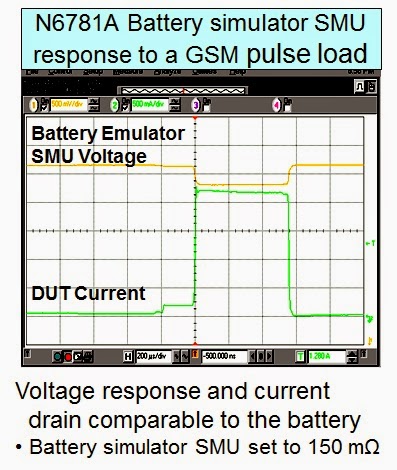A feature we’ve included on our 663xxA Mobile
Communications DC Sources, our N6781A 2-quadrant Source Measure Module, and
most recently our N69xxA and N79xxA Advanced Power System (APS) is the ability
to program in a value for a resistance that exists in series with the output
voltage. So why do we offer this?
Batteries are not
ideal voltage sources. They have a significant amount of equivalent series
resistance (ESR) on their output. Because of this, the battery’s output has a
voltage drop that is proportional to the current drawn by the DUT that is being
powered. An example of this is shown in the oscilloscope capture in Figure 1,
where a GPRS mobile handset is drawing pulsed transmit current from its
battery.
Figure 1: Battery voltage and current powering a GPRS
handset during transmit
In comparison, due to control feedback, a conventional DC
power supply has extremely low output impedance. At and near DC, for all
practical purposes, the DC output resistance is zero. At the same time, during
fast load current transition edges, many conventional DC power supplies can
have fairly slow transient voltage response, leading to significant transient
overshoots and undershoots with slow recovery during these transitions, as can
be seen in the oscilloscope capture in Figure 2.
Figure 2: Example general purpose bench power supply
powering a GPRS handset during transmit
It’s not hard to see that the general purpose bench power
supply voltage response is nothing close to that of the battery’s voltage
response and recognize that it will likely have a significant impact on the
performance of the GPRS handset. Just considering the performance of the
battery management, the battery voltage drop during loading and rise during
charging, due to the battery’s resistance, will impact discharge and charge
management performance.
We include programmable resistance in the above mentioned
DC power supplies as they are battery simulators. By being able to program a series output
resistance these power supplies are able to better simulate the voltage
response of a battery, as shown in Figure 3.
Figure 3: N6781A battery simulator DC source powering a
GPRS handset during transmit
While the 663xxA and N6781A are fairly low power meant to
simulate batteries for handheld mobile devices, The N69xxA and N79xxA APS units
are 1 and 2 KW power supplies meant to simulate much larger batteries used in
things like satellites, robotics, regenerative energy systems, and a number of
other higher power devices. Figure 4 shows the voltage response of an N7951A 1
KW APS unit programmed to 20 milliohms output impedance, having a +/- 10 amp
peak sine wave load current applied to its output.
Figure 4: N7951A 1 KW APS DC source voltage response to
sine wave load



